Charles E W Bean, Diaries, AWM38 3DRL 606/267/1 - 1914 - 1915 - Part 3
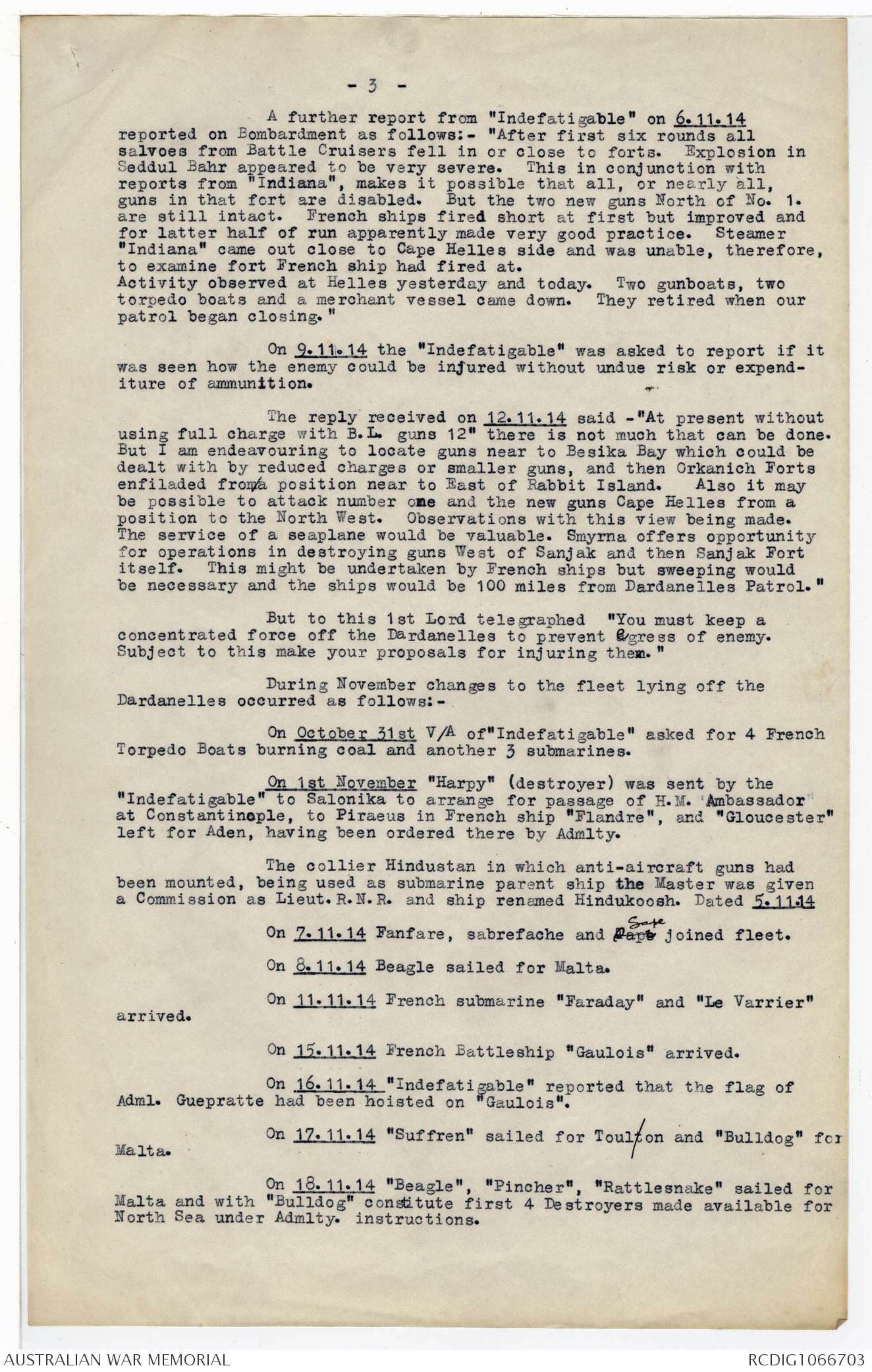
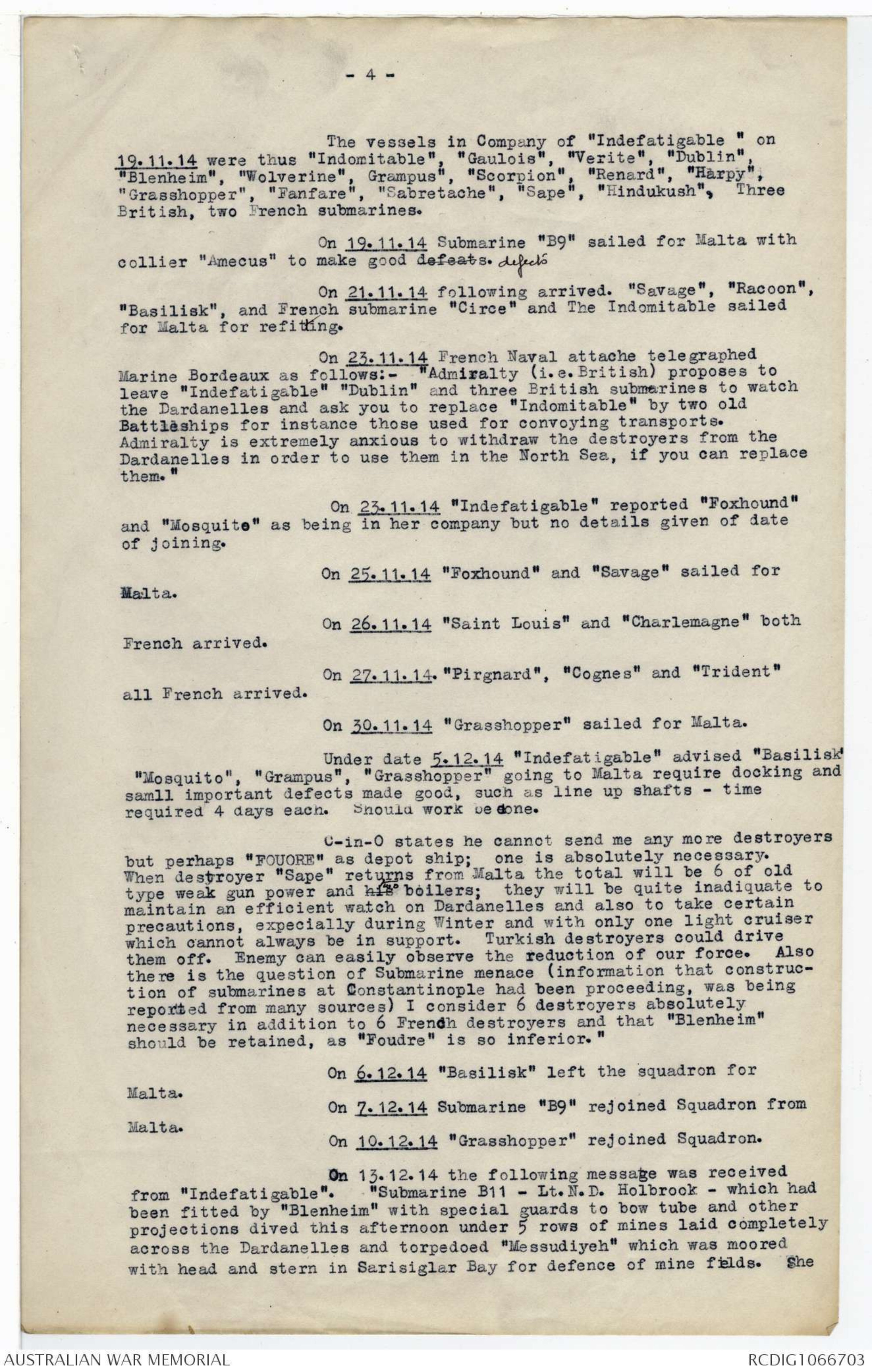
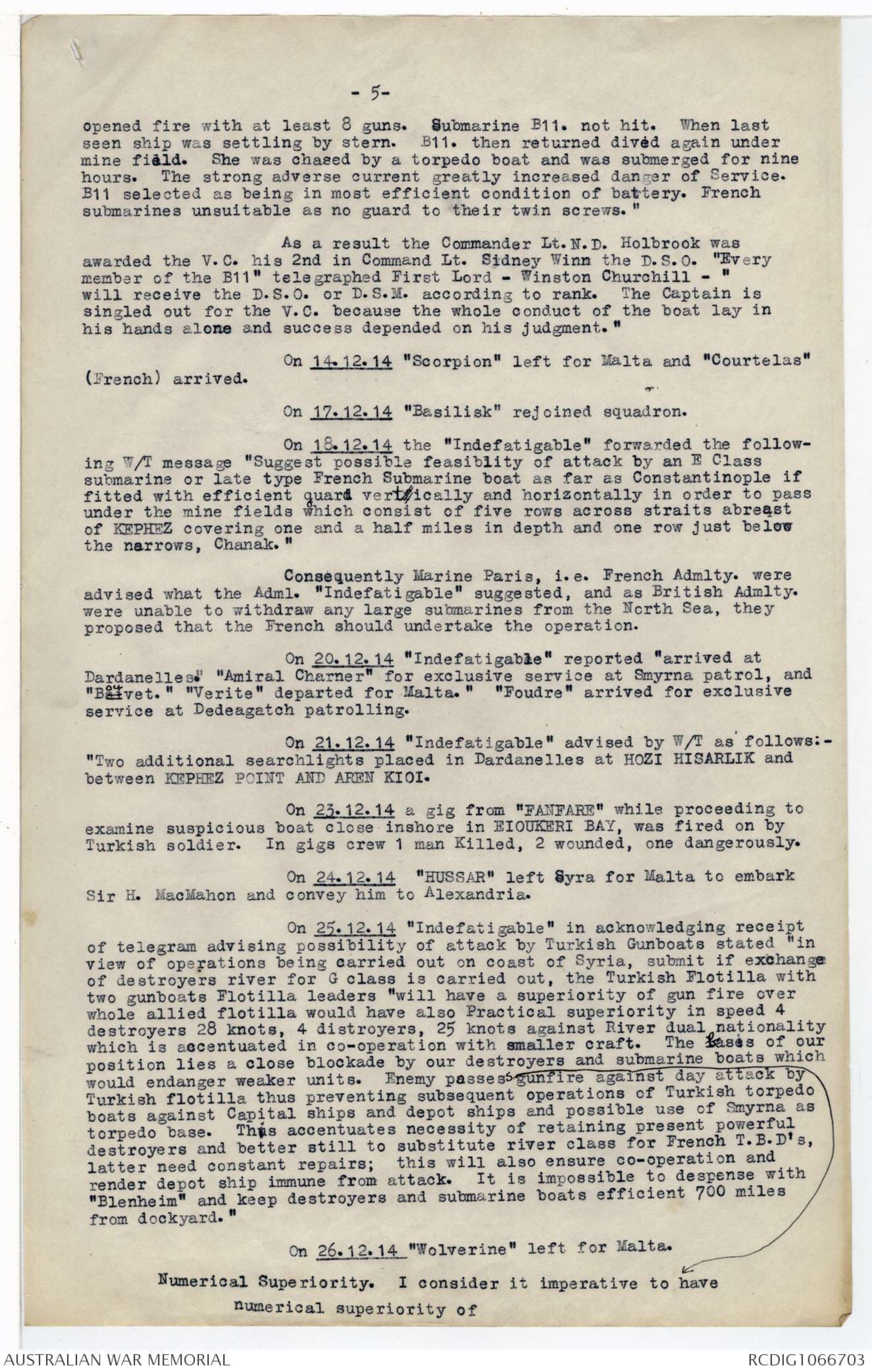
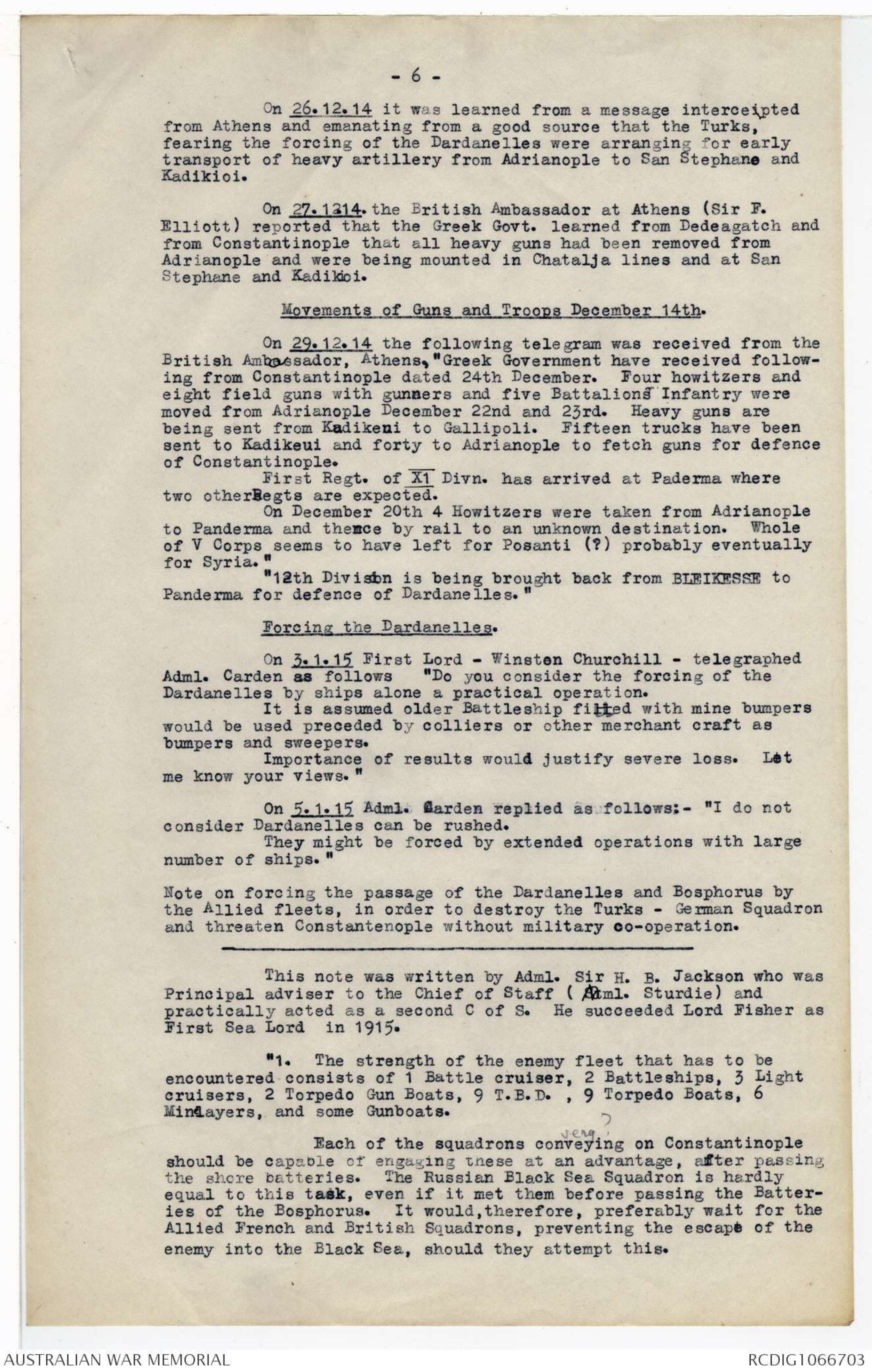

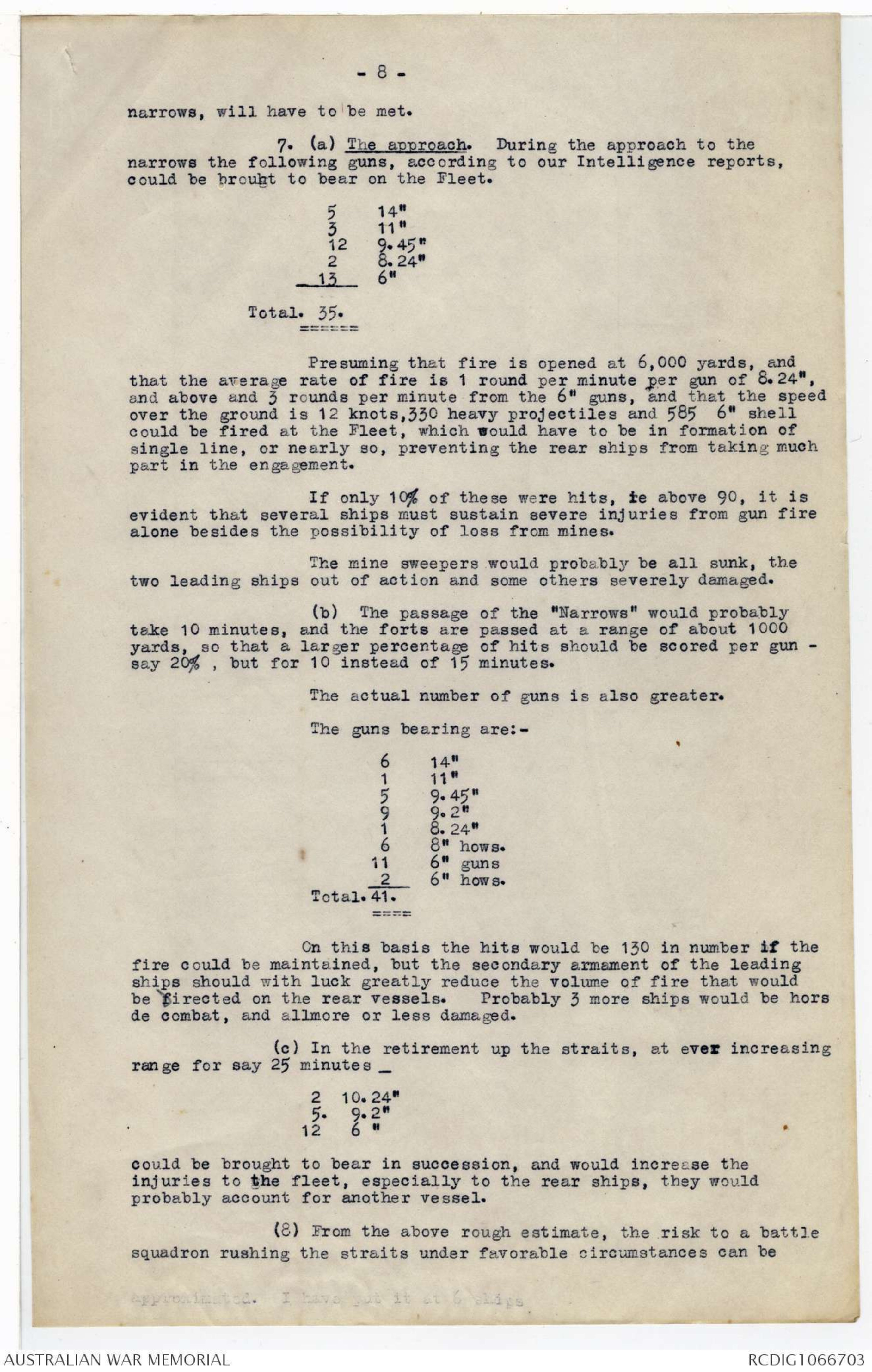
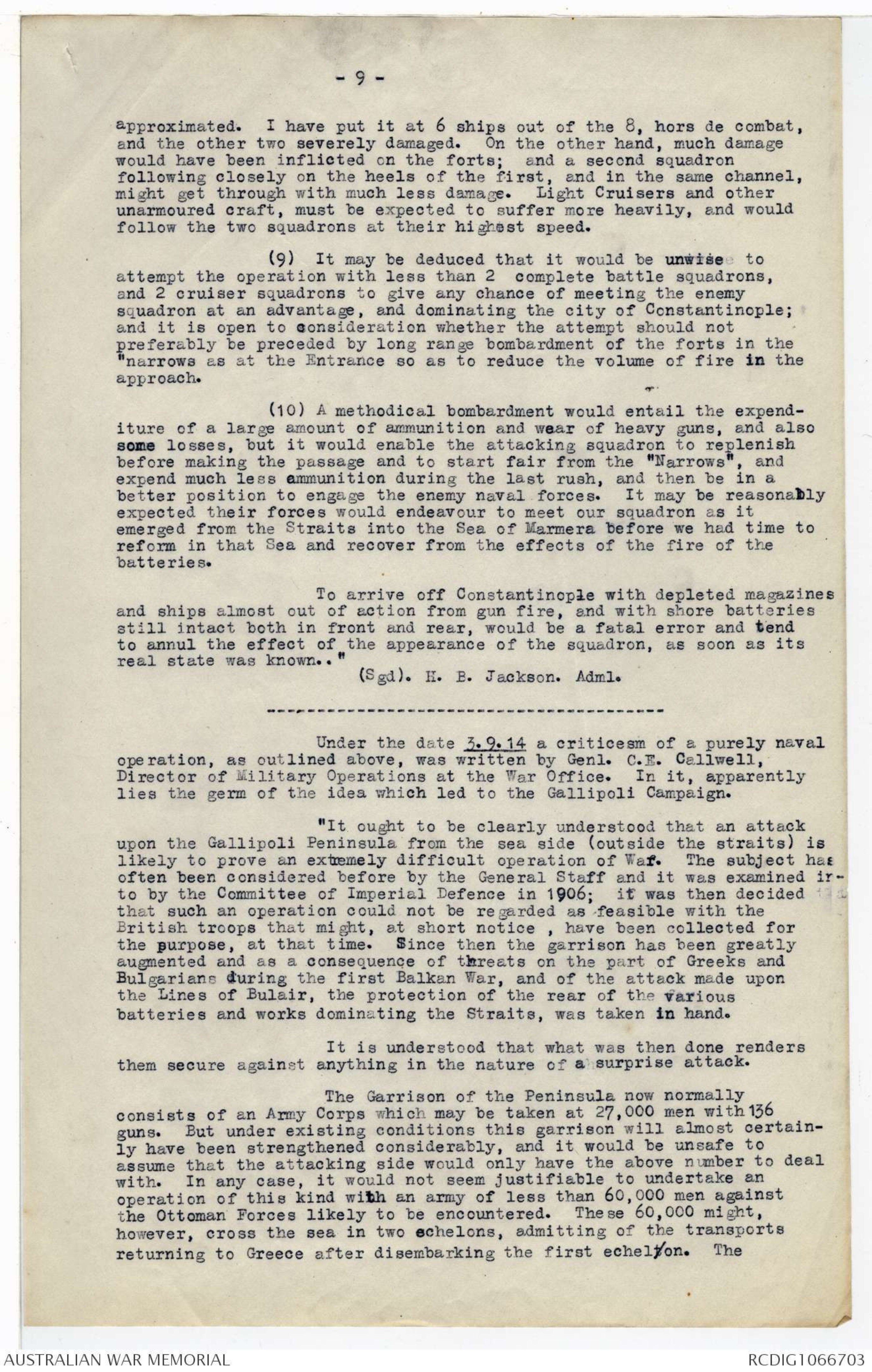
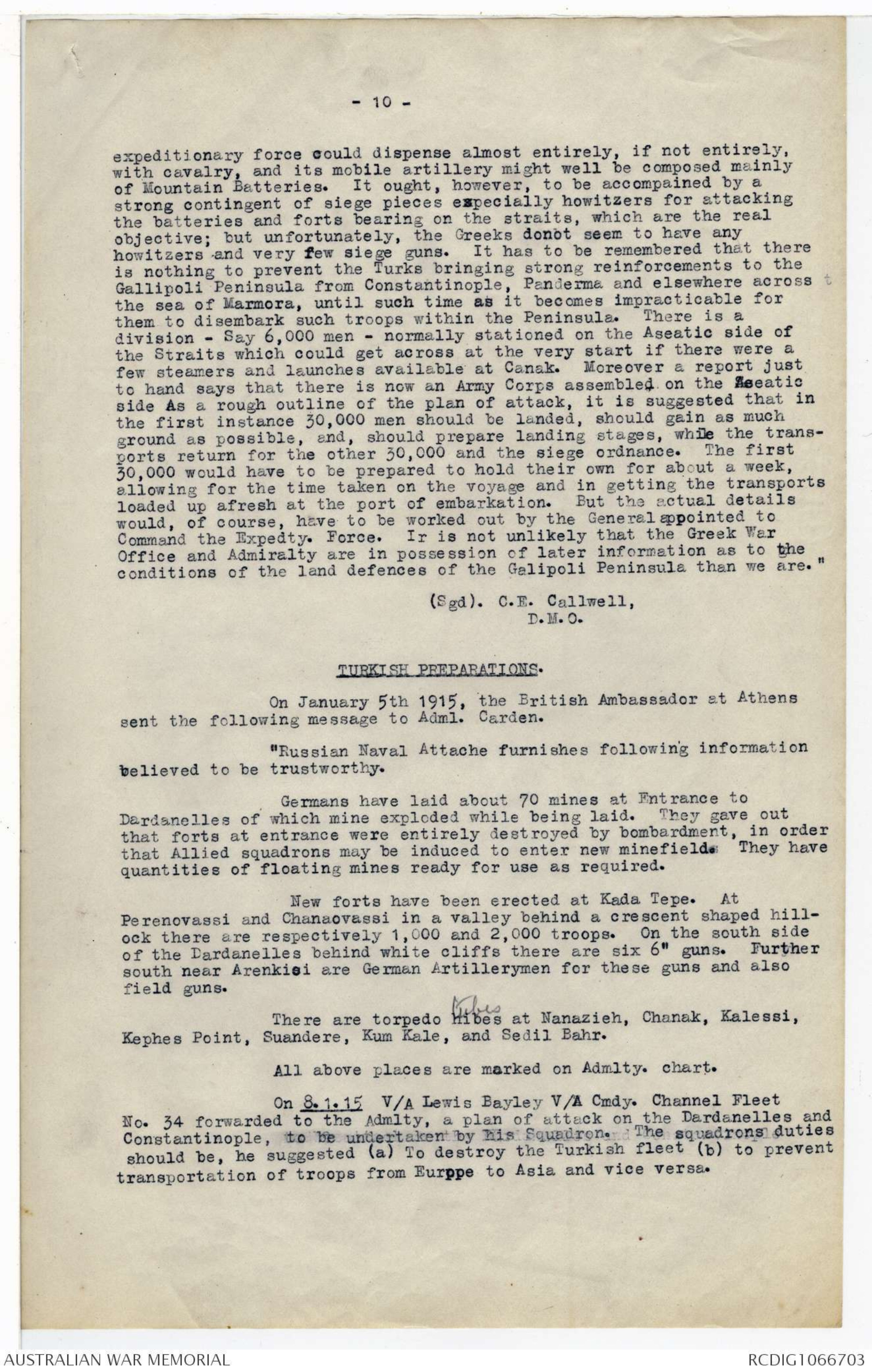
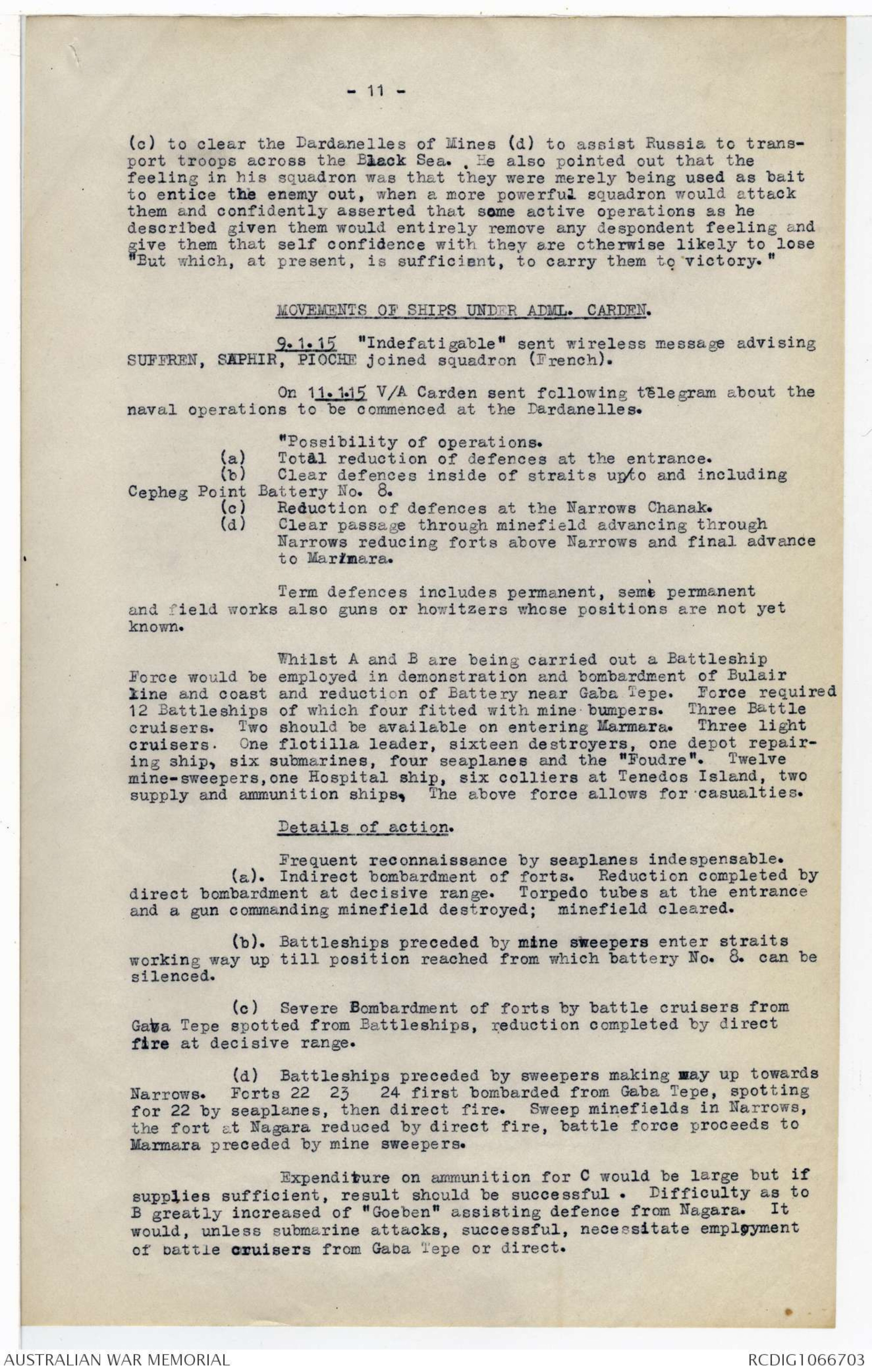

-3-
A further report from "Indefatigable" on 6.11.14
reported on Bombardment as follows:- "After first six rounds all
salvoes from Battle Cruisers fell in or close to forts. Explosion in
Seddul Bahr appeared to be very severe. This in conjunction with
reports from "Indiana", makes it possible that all, or nearly all,
guns in that fort are disabled. But the two new guns North of No. 1.
are still intact. French ships fired short at first but improved and
for latter half of run apparently made very good practice. Steamer
"Indiana" came out close to Cape Helles side and was unable, therefore,
to examine fort French ship had fired at.
Activity observed at Helles yesterday and today. Two gunboats, two
torpedo boats and a merchant vessel came down. They retired when our
patrol began closing.
On 9.11.14 the "Indefatigable" was asked to report if it
was seen how the enemy could be injured without undue risk or expenditure
of ammunition.
The reply received on 12.11.14 said -"At present without
using full charge with B.L. guns 12" there is not much that can be done.
But I am endeavouring to locate guns near to Besika Bay which could be
dealt with by reduced charges or smaller guns, and then Orkanich Forts
enfiladed from a position near to East of Rabbit Island. Also it may
be possible to attack number one and the new guns Cape Helles from a
position to the North West. Observations with this view being made.
The service of a seaplane would be valuable. Smyrna offers opportunity
for operations in destroying guns West of Sanjak and then Sanjak Fort
itself. This might be undertaken by French ships but sweeping would
be necessary and the ships would be 100 miles from Dardanelles Patrol.
But to this 1st Lord telegraphed "You must keep a
concentrated force off the Dardanelles to prevent aegress of enemy.
Subject to this make your proposals for injuring them."
During November changes to the fleet lying off the
Dardanelles occurred as follows:-
On October 31st V/A of"Indefatigable" asked for 4 French
Torpedo Boats burning coal and another 3 submarines.
On 1st November "Harpy" (destroyer) was sent by the
"Indefatigable" to Salonika to arrange for passage of H.M. Ambassador
at Constantinople, to Piraeus in French ship "Flandre", and "Gloucester"
left for Aden, having been ordered there by Admlty.
The collier Hindustan in which anti-aircraft guns had
been mounted, being used as submarine parent ship the Master was given
a Commission as Lieut.R.N.R. and ship renamed Hindukoosh. Dated 5.11.14
On 7.11.14 Fanfare, sabrefache and Pape Sape joined fleet.
On 8.11.14 Beagle sailed for Malta.
On 11.11.14 French submarine "Faraday" and "Le Varrier'
arrived.
On 15.11.14 French Battleship "Gaulois" arrived.
On 16.11.14 "Indefatigable" reported that the flag of
Adml. Guepratte had been hoisted on "Gaulois".
On 17.11.14 "Suffren" sailed for Toulton and "Bulldog" for
Malta.
On 18.11.14 "Beagle", "Pincher", "Rattlesnake" sailed for
Malta and with "Bulldog" constitute first 4 Destroyers made available for
North Sea under Admlty. instructions.
-4-
The vessels in Company of "Indefatigable" on
19.11.14 were thus "Indomitable", "Gaulois,"Verite", "Dublin"
"Blenheim", "Wolverine", Grampus", "Scorpion", "Renard", "Harpy"
"Grasshopper", "Fanfare", "Sabretache", "Sape", "Hindukush", Three
British, two French submarines.
On 19.11.14 Submarine "B9" sailed for Malta with
collier "Amecus" to make good defeats. defects
On 21.11.14 following arrived. "Savage", "Racoon",
"Basilisk", and French submarine "Circe" and The Indomitable sailed
for Malta for refithting.
On 23.11. 14 French Naval attache telegraphed
Marine Bordeaux as follows:- "Admiralty (i.e. British) proposes to
leave "Indefatigable" "Dublin" and three British submarines to watch
the Dardanelles and ask you to replace "Indomitable" by two old
Battleships for instance those used for convoying transports.
Admiralty is extremely anxious to withdraw the destroyers from the
Dardanelles in order to use them in the North Sea, if you can replace
them."
On 23. 11.14 "Indefatigable" reported "Foxhound"
and "Mosquito” as being in her company but no details given of date
of joining.
On 25.11.14 "Foxhound" and "Savage" sailed for
Malta.
On 26.11.14 "Saint Louis" and "Charlemagne" both
French arrived.
On 27.11.14."Pirgnard", "Cognes" and "Trident'
all French arrived.
On 30.11.14 "Grasshopper" sailed for Malta.
Under date 5.12.14 "Indefatigable" advised "Basilisk
"Mosquito", "Grampus", "Grasshopper" going to Malta require docking and
samll important defects made good, such as line up shafts - time
required 4 days each. Should work be done.
C-in-O states he cannot send me any more destroyers
but perhaps "FOUORE" as depot ship; one is absolutely necessary.
When destroyer "Sape" returns from Malta the total will be 6 of old
type weak gun power and his two boilers; they will be quite inadiquate to
maintain an efficient watch on Dardanelles and also to take certain
precautions, expecially during Winter and with only one light cruiser
which cannot always be in support. Turkish destroyers could drive
them off. Enemy can easily observe the reduction of our force. Also
there is the question of Submarine menace (information that construction
of submarines at Constantinople had been proceeding, was being
reported from many sources) I consider 6 destroyers absolutely
necessary in addition to 6 Frendch destroyers and that "Blenheim'
should be retained, as "Foudre" is so inferior.'
On 6.12.14 "Basilisk" left the squadron for
Malta.
On 7.12.14 Submarine "B9" rejoined Squadron from
Malta.
On 10.12.14 "Grasshopper" rejoined Squadron.
On 13.12.14 the following message was received
from "Indefatigable". "Submarine B11 - Lt.N.D. Holbrook - which had
been fitted by "Blenheim" with special guards to bow tube and other
projections dived this afternoon under 5 rows of mines laid completely
across the Dardanelles and torpedoed "Messudiyeh" which was moored
with head and stern in Sarisiglar Bay for defence of mine fields. She
-5-
opened fire with at least 8 guns. Submarine B11. not hit. When last
seen ship was settling by stern. B11. then returned divied again under
mine fileld. She was chased by a torpedo boat and was submerged for nine
hours. The strong adverse current greatly increased danger of Service.
B11 selected as being in most efficient condition of battery. French
submarines unsuitable as no guard to their twin screws."
As a result the Commander Lt. N. D. Holbrook was
awarded the V.C. his 2nd in Command Lt. Sidney Winn the D.S.O. "Every
member of the B11” telegraphed First Lord - Winston Churchill - "
will receive the D.S.O. or D.S.M. according to rank. The Captain is
singled out for the V.C. because the whole conduct of the boat lay in
his hands alone and success depended on his judgment."
On 14.12.14 "Scorpion" left for Malta and "Courtelas'
(French) arrived.
On 17.12.14 "Basilisk" rejoined squadron.
On 18.12.14 the "Indefatigable" forwarded the following
W/T message "Suggest possible feasibility of attack by an E Class
submarine or late type French Submarine boat as far as Constantinople if
fitted with efficient qguarld veriftically and horizontally in order to pass
under the mine fields which consist of five rows across straits abreast
of KEPHEZ covering one and a half miles in depth and one row just below
the narrows, Chanak."
Consequently Marine Paris, i.e. French Admlty, were
advised what the Adml. "Indefatigabele" suggested, and as British Admlty.
were unable to withdraw any large submarines from the North Sea, they
proposed that the French should undertake the operation.
On 20.12.14 "Indefatigable" reported "arrived at
Dardanelles" "Amiral Charner" for exclusive service at Smyrna patrol, and
Bouvet." "Verite' departed for Malta." "Foudre" arrived for exclusive
service at Dedeagatch patrolling.
On 21.12.14 "Indefatigable" advised by W/T as follows:-
"Two additional searchlights placed in Dardanelles at HOZI HISARLIK and
between KEPHEZ AND AREN KIOI.
On 23.12.14 a gig from "FANFARE" while proceeding to
examine suspicious boat close inshore in EIOUKERI BAY, was fired on by
Turkish soldier. In gigs crew 1 man Killed, 2 wounded, one dangerously.
On 24.12.14 "HUSSAR" left Syra for Malta to embark
Sir H. MacMahon and convey him to Alexandria.
On 25.12.14 "Indefatigable" in acknowledging receipt
of telegram advising possibility of attack by Turkish Gunboats stated "in
view of operations being carried out on coast of sSyria, submit if exchange
of destroyers river for G class is carried out, the Turkish Flotilla with
two gunboats Flotilla leaders "will have a superiority of gun fire over
whole allied flotilla would have also Practical superiority in speed 4
destroyers 28 knots, 4 distroyers, 25 knots against River dual, nationality
which is accentuated in co-operation with smaller craft. The lbaseis of our
position lies a close blockade by our destroyers and submarine boats which
would endanger weaker units. Enemy passess gunfire against day attack by
Turkish flotilla thus preventing subsequent operations of Turkish torpedo
boats against Capital ships and depot ships and possible use of Smyrna as
torpedo base. Thuis accentuates necessity of retaining present powerful
destroyers and better still to substitute river class for French T.B.D's,
latter need constant repairs; this will also ensure co-operation and
render depot ship immune from attack. It is impossible to despense with
"Blenheim" and keep destroyers and submarine boats efficient 700 miles
from dockyard."
On 26.12.14 "Wolverine" left for Malta.
Numerical Superiority. I consider it imperative to have
numerical superiority of
-6-
On 26.12.14 it was learned from a message interceipted
from Athens and emanating from a good source that the Turks,
fearing the forcing of the Dardanelles were arranging for early
transport of heavy artillery from Adrianople to San Stephane and
Kadikioi.
On 27.12.14 the British Ambassador at Athens (Sir F.
Elliott) reported that the Greek Govt. learned from Dedeagatch and
from Constantinople that all heavy guns had been removed from
Adrianople and were being mounted in Chatalja lines and at San
Stephane and Kadikioi.
Movements of Guns and Troops December 14th.
On 29.12.14 the following telegram was received from the
British Ambassador, Athens, "Greek Government have received following
from Constantinople dated 24th December. Four howitzers and
eight field guns with gunners and five Battalions Infantry were
moved from Adrianople December 22nd and 23rd. Heavy guns are
being sent from Kadikeni to Gallipoli. Fifteen trucks have been
sent to Kadikeui and forty to Adrianople to fetch guns for defence
of Constantinople.
First Regt. of X1 Divn. has arrived at Paderma where
two othersRegts are expected.
On December 20th 4 Howitzers were taken from Adrianople
to Panderma and themnce by rail to an unknown destination. Whole
of V Corps seems to have left for Posanti (?) probably eventually
for Syria."
"12th Division is being brought back from BLEIKESSE to
Panderma for defence of Dardanelles."
Forcing the Dardanelles.
On 3. 1. 15 First Lord - Winsteon Churchill - telegraphed
"Do you consider the forcing of the
Adml. Carden as follows "Do you consider the forcing of the
Dardanelles by ships alone a practical operation.
It is assumed older Battleship filltted with mine bumpers
would be used preceded by colliers or other merchant craft as
bumpers and sweepers.
Importance of results would justify severe loss. Let
me know your views."
On 5.1.15 Adml. ACarden replied as follows:- "I do not
consider Dardanelles can be rushed.
They might be forced by extended operations with large
number of ships."
Note on forcing the passage of the Dardanelles and Bosphorus by
the Allied fleets, in order to destroy the Turks - German Squadron
and threaten Constantenople without military co-operation.
This note was written by Adml. Sir H. B. Jackson who was
Principal adviser to the Chief of Staff ( SiAml. Sturdie) and
practically acted as a second C of S. He succeeded Lord Fisher as
First Sea Lord in 1915.
"1. The strength of the enemy fleet that has to be
encountered consists of 1 Battle cruiser, 2 Battleships, 3 Light
cruisers, 2 Torpedo Gun Boats, 9 T.B.D., 9 Torpedo Boats, 6
Minelayers, and some Gunboats.
Each of the squadrons conveying^verg? on Constantinople
should be capable of engaging these at an advantage, after passing
the shore batteries. The Russian Black Sea Squadron is hardly
equal to this task, even if it met them before passing the Batteries
of the Bosphorus. It would, therefore, preferably wait for the
Allied French and British Squadrons, preventing the escape of the
enemy into the Black Sea, should they attempt this.
-7-
Consequently the French and British squadrons must
arrive at Constantinople in sufficient force to engage the enemy
squadron, and also dominate the situation at Constantinople. The
least that can do this would be 1 Battle Cruiser, a Battle Squadron
(8), with cruisers and torpedo craft in proportion.
2. Assuming the enemy squadron destroyed and the
batteries rushed, they would be open to the fire of field artillery
and infantry, and to torpedo attack at night, with no store ships
with communication, and no retreat without reengaging the shore batteries,
unless these had been destroyed when forcing the passage.
Though they might dominate the city and inflict enormous
damage, their position would not be an enviable one unless there were
a large military force to occupy the town.
3. Strategically, such a diversion would only be
carried cut when the object to be gained was commensurate with the loss
the Fleet would sustain in forcing the passage.
The actual capture of Constantinople would be worth a
considerable loss, but its bombardment alone would not greatly affect
the distant military operations, and even if it surrended, it could
not be occupied and held without troops and would probably result in
indiscriminate massacres.
2. Scheme for rushing the passage.
4. The attack should be as much in the nature of a
surprise attack as possible, but before this is attempted, it is most
desirable the guns mounted in the defences at the entrance be entirely
demolished, in order to lessen the losses to the attacking squadron.
This would necessitate a much more determined attack on these forts
than was carried out in November last, and the landing of demolition
parties with gun cotton or thermit to actually destroy the guns. The
20 heavy guns mounted in the 7 forts at the entrance are old and short
range guns, and most could probably be put out of action bylong range
fire before closing the Forts and subjecting them to a searching fire
at moderate range. Some losses, however, must be expected.
When these outer forts are entirely silenced,
armoured ships could enter the straits subject only to fire from
Field Artillery, and the damage from mines and torpedo attack. A line
of retreat from the narrows would be open to them, and this is a point
of great importance for future operations, as ships injured and not
under control before reaching the narrows, would drift in the strong
S.W. current to the Mediterranean without being subject to heavy
hostile fire, and the destruction of these outer forts would be a gain
of about 10 miles and the 35 miles of dangerous water to be passed
through.
Their destruction would also simplify the operation
of the blockade of the straits, in reducing the area to be watched,
and is an operation well worth serious consideration.
6. Assuming the outer defences have been permanently
silenced, the waters of the straits as far up towards the narrows as
possible, should be swept for mines. There are occasionally foggy
nights in winter, and one of these should be selected for the passage
of the straits. The squadron should be preceded by Mine Sweepers as
long as they remain afloat, and the attack should be as much a
surprise as possible.
The distance under heavy fire in the narrows will be
about 12 miles - say 1 hour's steaming against the current. The
passage may be divided into three phases: the approach; the close
engagement; and the retirement up the straits; during the latter,
intermittent fire from batteries more isolated than they are at the
-8 -
narrows, will have to be met.
7. (a) The approach. During the approach to the
narrows the following guns, according to our Intelligence reports,
could be brought to bear on the Fleet.
5 14"
3 11"
12 9.45"
2 8.24"
13 6"
Total. 35.
Presuming that fire is opened at 6,000 yards, and
that the average rate of fire is 1 round per minute per gun of 8.24"
and above and 3 rounds per minute from the 6” guns, and that the speed
over the ground is 12 knots,330 heavy projectiles and 585 6" shell
could be fired at the Fleet, which would have to be in formation of
single line, or nearly so, preventing the rear ships from taking much
part in the engagement.
If only 10% of these were hits, rie above 90, it is
evident that several ships must sustain severe injuries from gun fire
alone besides the possibility of loss from mines.
The mine sweepers would probably be all sunk, the
two leading ships out of action and some others severely damaged.
(b) The passage of the "Narrows" would probably
take 10 minutes, and the forts are passed at a range of about 1000
yards, so that a larger percentage of hits should be scored per gun -
say 20%, but for 10 instead of 15 minutes.
The actual number of guns is also greater.
The guns bearing are:-
6 14"
1 11"
5 9.45"
9 9.24
1 8.24"
6 8" hows.
11 6" guns
2 6" hows.
Total.41.
On this basis the hits would be 130 in number if the
fire could be maintained, but the secondary armament of the leading
ships should with luck greatly reduce the volume of fire that would
be directed on the rear vessels. Probably 3 more ships would be hors
de combat, and allmore or less damaged.
(c) In the retirement up the straits, at ever increasing
range for say 25 minutes -
1 10.24"
5. 9.2"
12 6"
could be brought to bear in succession, and would increase the
injuries to the fleet, especially to the rear ships, they would
probably account for another vessel.
(8) From the above rough estimate, the risk to a battle
squadron rushing the straits under favorable circumstances can be
-9 -
approximated. I have put it at 6 ships out of the 8, hors de combat,
and the other two severely damaged. On the other hand, much damage
would have been inflicted on the forts; and a second squadron
following closely on the heels of the first, and in the same channel,
might get through with much less damage. Light Cruisers and other
unarmoured craft, must be expected to suffer more heavily, and would
follow the two squadrons at their highest speed.
(9) It may be deduced that it would be unwisee to
attempt the operation with less than 2 complete battle squadrons,
and 2 cruiser squadrons to give any chance of meeting the enemy
squadron at an advantage, and dominating the city of Constantinople;
and it is open to consideration whether the attempt should not
preferably be preceded by long range bombardment of the forts in the
"narrows as at the Entrance so as to reduce the volume of fire in the
approach.
(10) A methodical bombardment would entail the expenditure
of a large amount of ammunition and wear of heavy guns, and also
some losses, but it would enable the attacking squadron to replenish
before making the passage and to start fair from the "Narrows", and
expend much less ammunition during the last rush, and then be in a
better position to engage the enemy naval forces. It may be reasonalbly
expected their forces would endeavour to meet our squadron as it
emerged from the Straits into the Sea of Marmera before we had time to
reform in that Sea and recover from the effects of the fire of the
batteries.
To arrive off Constantinople with depleted magazines
and ships almost out of action from gun fire, and with shore batteries
still intact both in front and rear, would be a fatal error and tend
to annul the effect of the appearance of the squadron, as soon as its
real state was known.."
(Sgd). H. B. Jackson. Adml.
--------
Under the date 3.9.14 a criticesm of a purely naval
operation, as outlined above, was written by Genl. C. E. Callwell
Director of Military Operations at the War Office. In it, apparently
lies the germ of the idea which led to the Gallipoli Campaign.
"It ought to be clearly understood that an attack
upon the Gallipoli Peninsula from the sea side (outside the straits) is
likely to prove an extemely difficult operation of Waf. The subject has
often been considered before by the General Staff and it was examined ir-
to by the Committee of Imperial Defence in 18906; if was then decided
that such an operation could not be regarded as feasible with the
British troops that might, at short notice , have been collected for
the purpose, at that time. Since then the garrison has been greatly
augmented and as a consequence of threats on the part of Greeks and
Bulgarians during the first Balkan War, and of the attack made upon
the Lines of Bulair, the protection of the rear of the various
batteries and works dominating the Straits, was taken in hand.
It is understood that what was then done renders
them secure against anything in the nature of a surprise attack.
The Garrison of the Peninsula now normally
consists of an Army Corps which may be taken at 27,000 men with 136
guns. But under existing conditions this garrison will almost certainly
have been strengthened considerably, and it would be unsafe to
assume that the attacking side would only have the above number to deal
with. In any case, it would not seem justifiable to undertake an
operation of this kind with an army of less than 60,000 men against
the Ottoman Forces likely to be encountered. These 60,000 might
however, cross the sea in two echelons, admitting of the transports
returning to Greece after disembarking the first echelton. The
- 10 -
expeditionary force could dispense almost entirely, if not entirely,
with cavalry, and its mobile artillery might well be composed mainly
of Mountain Batteries. It ought, however, to be accompained by a
strong contingent of siege pieces expecially howitzers for attacking
the batteries and forts bearing on the straits, which are the real
objective; but unfortunately, the Greeks donot seem to have any
howitzers and very few siege guns. It has to be remembered that there
is nothing to prevent the lurks bringing strong reinforcements to the
Gallipoli Peninsula from Constantinople, Panderma and elsewhere across t
the sea of Marmora, until such time as it becomes impracticable for
them to disembark such troops within the Peninsula. There is a
division - Say 6,000 men - normally stationed on the Aseatic side of
the Straits which could get across at the very start if there were a
few steamers and launches available at Canak. Moreover a report just
to hand says that there is now an Army Corps assembled on the Aseatic
side As a rough outline of the plan of attack, it is suggested that in
the first instance 30,000 men should be landed, should gain as much
ground as possible, and, should prepare landing stages, whie the trans-
ports return for the other 30,000 and the siege ordnance. The first
30,000 would have to be prepared to hold their own for about a week,
allowing for the time taken on the voyage and in getting the transports
loaded up afresh at the port of embarkation. But the actual details
would, of course, have to be worked out by the General appointed to
Command the Expedty. Force. Ir is not unlikely that the Greek War
Office and Admiralty are in possession of later information as to the
conditions of the land defences of the Galipoli Peninsula than we are.
(Sgd). C.E. Callwell,
D.M.O.
TURKISH PREPARATIONS.
On January 5th 1915, the British Ambassador at Athens
sent the following message to Adml. Carden.
"Russian Naval Attache furnishes following information
believed to be trustworthy.
Germans have laid about 70 mines at Entrance to
Dardanelles of which mine exploded while being laid. They gave out
that forts at entrance were entirely destroyed by bombardment, in order
that Allied squadrons may be induced to enter new minefield- They have
quantities of floating mines ready for use as required.
New forts have been erected at Kada Tepe. At
Perenovassi and Chanaovassi in a valley behind a crescent shaped hillock
there are respectively 1,000 and 2,000 troops. On the south side
of the Dardanelles behind white cliffs there are six 6” guns. Further
south near Arenkiei are German Artillerymen for these guns and also
field guns.
There are torpedo hibes tubes at Nanazieh, Chanak, Kalessi,
Kephes Point, Suandere, Kum Kale, and Sedil Bahr.
All above places are marked on Admlty. chart.
On 8.1.15 V/A Lewis Bayley V/A Cmdy. Channel Fleet
No. 34 forwarded to the Admlty, a plan of attack on the Dardanelles and
Constantinople, to be undertaken by his Squadron. The squadrons duties
should be, he suggested (a) To destroy the Turkish fleet (b) to prevent
transportation of troops from Eurppe to Asia and vice versa.
- 11 -
(c) to clear the Dardanelles of Mines (d) to assist Russia to transport
troops across the Black Sea., He also pointed out that the
feeling in his squadron was that they were merely being used as bait
to entice the enemy out, when a more powerful squadron would attack
them and confidently asserted that some active operations as he
described given them would entirely remove any despondent feeling and
give them that self confidence with they are otherwise likely to lose
"But which, at present, is sufficient, to carry them to victory."
MOVEMENTS OF SHIPS UNDER ALML. CARDEN.
9.1.15 "Indefatigable" sent wireless message advising
SUFFREN, SAPHIR, PIOCHE joined squadron (French).
On 11.1.15 V/A Carden sent following telegram about the
naval operations to be commenced at the Dardanelles.
"Possibility of operations.
(a) Total reduction of defences at the entrance.
(b) Clear defences inside of straits up to and including
Cepheg Point Battery No. 8.
(c) Reduction of defences at the Narrows Chanak.
(d) Clear passage through minefield advancing through
Narrows reducing forts above Narrows and final advance
to Marimara.
Term defences includes permanent, semei permanent
and field works also guns or howitzers whose positions are not yet
known.
Whilst A and B are being carried out a Battleship
Force would be employed in demonstration and bombardment of Bulair
kline and coast and reduction of Battery near Gaba Tepe. Force required
12 Battleships of which four fitted with mine bumpers. Three Battle
cruisers. Two should be available on entering Marmara. Three light
cruisers. One flotilla leader, sixteen destroyers, one depot repairing
ship, six submarines, four seaplanes and the "Foudre". Twelve
mine-sweepers, one Hospital ship, six colliers at Tenedos Island, two
supply and ammunition ships, The above force allows for casualties.
Details of action.
Frequent reconnaissance by seaplanes indespensable.
(a). Indirect bombardment of forts. Reduction completed by
direct bombardment at decisive range. Torpedo tubes at the entrance
and a gun commanding minefield destroyed; minefield cleared.
(b). Battleships preceded by mine sweepers enter straits
working way up till position reached from which battery No. 8. can be
silenced.
(c) Severe Bombardment of forts by battle cruisers from
Gata Tepe spotted from Battleships, reduction completed by direct
fire at decisive range.
(d) Battleships preceded by sweepers making may up towards
Narrows. Forts 22 23 24 first bombarded from Gaba Tepe, spotting
for 22 by seaplanes, then direct fire. Sweep minefields in Narrows,
the fort at Nagara reduced by direct fire, battle force proceeds to
Marmara preceded by mine sweepers.
Expenditure on ammunition for C would be large but if
supplies sufficient, result should be successful. Difficulty as to
B greatly increased of "Goeben" assisting defence from Nagara. It
would, unless submarine attacks, successful, necessitate emplyoyment
of battle cruisers from Gaba Tepe or direct.
-12 -
Time required for operations depends greatly on morale
of enemy under bonbardment, garrison layely largely.
"Stiffened by Germans, also on the weather conditions.
Gales now frequent. Might do it all in a month about. Expenditure
of ammunition would be large. Approximate estimate of quantity required
being prepared.
Disposition of Squadron on completion of operations.
Marmara 2 battle cruisers, 4 battleships, 3 light cruisers,
1 flotilla leader, 12 TB distroyers, 3 submarines, 1 supply and ammunition
ship, 4 mine sweepers, collier,
Remainder of force keeping straits open and covering mine
sweepers completing clearly minefield."
On this report, V/Z Sir H. B. Jackson, wrote a memorandum
on 15.1.15, concurring with the plans generally as drawn up by V/A
Carden and pointing out that it differed from his own merely in small
detail.
In estimating the amount of ammunition required, he took
the November 14th bombardment as a comparison, and found an average of
10 rounds per gun would probably be required at extreme range.
From this he deducts a total of 3,000 shells would be
used on the primary armaments and 3,000 on the secondary armaments.
He also pointed out that during the previous bombardment
shells from the forts fell along our Battle cruisers at a range of
12,300 yards and therefore considered that in the early stages it
imprudent to close to less than 13,000 yards.
He sums up that in his estimation the operation should
not be attempted unless we are prepared to expend the 6,000 rounds
referred to above, besides the loss of some vessels.
He suggest "A" should be approved at once for the
value of its experience and it should be carried out under favorable
light conditions and continued, with spotting ships, until all guns
at the entrance are permanently silenced.
On 12.1.15 the COUTELAS (French destroyer) left V/A
Cardens squadron for Malta.
On. 12/1/15 the first Lord wired V/A Carden asking
if he meant by Battle Cruisers, Dreadnaughts" with modern guns, but
high speed not essential. Also asking him to consider the effect of
using "Queen Elizabeth" 15 guns for A. B. & C, their pow, accuracy and
range far exceeding any other weapons.
On same day - 12.1.15 Indefatigable reported that
H.M.S. "COLNE" and"JED" joined the squadron.
On 13.1.15 V/A Carden replied to First Lords query
as above, that high speed was considered necessary for meeting the
"Goeben" in Marmora, that the "Queen Elizabeth" was very desirable and
should certainly shorten operations. He estimated there were a total
of 330 mines in various parts of Dardanelles, in eight lines.
On 15.1.15 the First Lord telegraphed V/A Carden as
follows:- "Your scheme was laid by the First Sea Lord and myself,
before the War Cabinet Council yesterday, and was approved in
principle. We see no difficulty in providing the force you require
including the "Queen Elizabeth" by the 15th Feby.
We entirely agree with your plan of methodical
 dm
dmThis transcription item is now locked to you for editing. To release the lock either Save your changes or Cancel.
This lock will be automatically released after 60 minutes of inactivity.